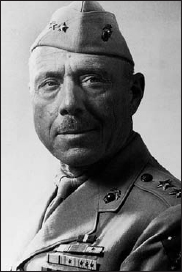
On 29 May 1944 Admiral Chester Nimitz, as Commander-in-Chief, Pacific Fleet and Pacific Ocean Area (CINCPAC-POA), issued orders for plans to be drawn up for the invasion of the Palau Islands under the codename Operation Stalemate.

MajGen William H. Rupertus, Commanding General 1st Mar. Div. At 55 years old Rupertus was not a flamboyant officer but was well thought of by many ranking generals in the Marine Corps including the then Commandant and former Commanding Officer, 1st Mar. Div., General Archer A. Vandegrift. Rupertus, like many of his fellow 1st Mar. Div. officers, had seen overseas duty prior to World War II including command of 1st Battalion, 4th Marines in Shanghai, where he clashed several times with Japanese troops. It was during his tour of duty in China that Rupertus lost his wife, daughter and son through illness, which left him very moody with bouts of depression. Rupertus had total confidence in the ability of his 1st Mar. Div. and would insist several times during the Peleliu battle that the island would be taken “shortly” by his Marines alone. Pushing his regimental commanders to the limit and possibly beyond in the case of Chesty Puller and his 1st Marines.
The assault would be carried out in the south by III Amphibious Corps (IIIAC) against the islands of Peleliu and Angaur. At the same time, the Army’s XXIV Corps would land on the main Palaus island of Babelthuap. The target date was 8 September 1944.
Soon after operational planning had commenced, several problems became evident. The Guam invasion had fallen behind schedule and was tying up IIIAC (3rd Mar. Div., 1st Provisional Marine Brigade, and 77th Inf. Div.), which were included in Operation Stalemate. Also, much of the shipping for Stalemate was unavailable due to its continued requirements in the Marianas.
Intelligence was gathered by aerial reconnaissance photographs. Also, in June 1944 the submarine USS Seawolf (SS-197) carried out photographic reconnaissance of the invasion landing beaches. A further reconnaissance was carried out by the submarine USS Burrfish (SS-312) on Peleliu and Yap beaches. An 11-man reconnaissance group of underwater demolition team (UDT) frogmen landed on the Peleliu beaches from the Burrfish for closer investigation relating to water depth, location of potholes and sandbars, and obstacles. With thousands of Japanese on the island they understandably did not reconnoiter inland, and the rugged terrain of the interior would come as an unpleasant surprise to the Marines. A similar operation was carried out on the Yap invasion beaches, but this time only two of a five-man reconnaissance team made it back to the pick-up point. After several unsuccessful attempts to locate their missing comrades the remaining two men returned to the Burrfish.
After this incident, Admiral Nimitz banned any further missions of this type. These reconnaissance missions revealed a large Japanese garrison on Babelthuap and that the island was suitable for the construction of only a limited airstrip and facilities. Whereas on Peleliu in the south there already existed an excellent operational airfield and space on Angaur for a further airstrip and facilities. Tactically, there was no reasonable justification to invade Babelthuap at all.
The most significant intelligence information to come the Americans’ way was collected on the island of Saipan after its fall in July 1944. Files of the Japanese 31st Army headquarters were captured, and along with the fortuitous capture of a Japanese intelligence officer, these files revealed, among other things, the table of organization for the Peleliu and Angaur garrisons. These tables indicated troop strengths on Peleliu as 10,500 and on Angaur roughly 1,400 men. As a result of the various intelligence gathering efforts, and due to the Marianas campaign running behind schedule, CINCPOA issued a second warning order on 7 July canceling Operation Stalemate and replacing it with a revised plan under the codename of Operation Stalemate II, with a revised target date of 15 September.
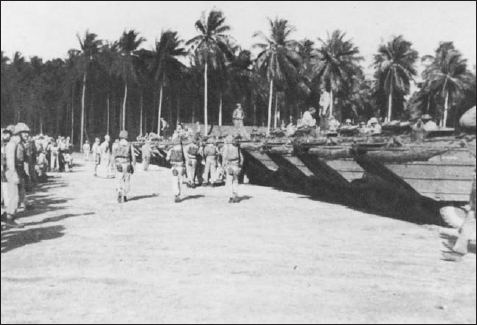
Men of the 1st Mar. Div. practice boarding and debarking from DUKWs, amphibious 2½ ton trucks, used by the Marines for the first time on Peleliu. DUKWs carrying artillery and ammunition following the assault waves were destroyed because of their lack of armor.
An unusual staff arrangement was established to plan Stalemate II. IIIAC was committed to take Guam under MajGen Geiger. The IIIAC staff would be unable to plan the Palaus operation, which it was to execute. Marine MajGen Julian Smith, designated to command the Expeditionary Troops (TF 36 – the Marine and Army landing forces), was tasked to plan the operation using his own small staff augmented by some IIIAC staff officers. This temporary planning staff was designated X-Ray Provisional Amphibious Corps. It would plan the operation and IIIAC would execute it – an awkward arrangement, but necessary in order to maintain the increasing tempo of operations. X-Ray was dissolved on 15 August 1944.
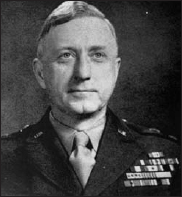
MajGen Paul J. Mueller, US Army. Commanding General 81st Inf. Div. (“Wildcats”) Mueller had been with the 81st throughout training both on mainland USA and Jungle Warfare Center on Hawaii. He was confident that although lacking the combat experience of the 1st Mar. Div., his 781st “Wildcats” were just as ready for the forthcoming invasion of Peleliu. Mueller would eventually take over command of garrisoning Peleliu and the “mopping up” operations which were to last several months after Peleliu had been declared secure.
Operation Stalemate II called for IIIAC as Western Landing Force and Troops (TG 36.1) to assault the islands of Peleliu with the 1st Mar. Div. as the Peleliu Landing Force (Task Unit 36.1.1) and Angaur with the 81st Inf. Div. as Angaur Landing Force (TG 36.2) as in the original Stalemate plan. In a change to the plan, however, in floating reserve would be the 77th Inf. Div. (TG 36.3), with the 5th Mar. Div. (TG 36.4) as the area reserve, at this time based on Hawaii. D-Day was set for 15 September 1944. The second phase of Stalemate II required XXIV Corps to assault the islands of Yap and Ulithi to the northeast of the Palaus on 8 October, substituting the 96th Inf. Div. for the 77th Inf. Div. who were now in reserve for IIIAC.
To support Phases I and II, the Third Fleet (Western Pacific Task Force) split its forces. The Covering Forces and Special Groups (TF 30) were retained directly under Halsey’s control. The Third Amphibious Force (TF 31) was divided into the Western Attack Force (TF 32) for Peleliu and Angaur under Rear Admiral George H. Fort and the Eastern Attack Force (TF 33) for Yap and Ulithi under Vice Admiral Theodore S. Wilkinson (also Commander, Third Amphibious Force). TF 32 itself was split into the Peleliu Attack Group (TG 32.1) with the 1st Mar. Div. directly under Admiral Fort and the Angaur Attack Group (TG 32.2) with the 81st Inf. Div. under Rear Admiral William H.P. Blandly. The Western Fire Support Group (TG 32.7) under Rear Admiral Jesse B. Oldendorf consisted of five battleships, five heavy and three light cruisers, and 14 destroyers. Eleven escort carriers of Escort Carrier Group (TG 31.2) under Rear Admiral Ralph A. Ofstie provided close air support, combat air patrols, and antisubmarine patrols, although some were detached during the operation reducing the force to seven. The Kossol Passage Detachment (TG 32.9) would sweep the passage north of Babelthuap to establish a temporary fleet anchorage and seaplane base.
CINCPAC–CINCPOA: Admiral Chester Nimitz
Western Pacific Task Forces (Third Fleet): Admiral William F. Halsey
Joint Expeditionary Force (Task Force 31) (III Amphibious Force): Vice Admiral Theodore S. Wilkinson
Fire Support Group (Task Group 31.1): Rear Admiral Jesse B. Oldendorf
Escort carrier Group (Task Group 31.9): Rear Admiral Ralph A. Ofstie
Mine Sweeping Group (Task Group 31.3): Commander Wayne R. Loud
Western Garrison Group (Task Group 31.4): Commander Charles A. MacGowan
Western Attack Force (Task Force 32): Rear Admiral George H. Fort Kossol Passage Detachment (Task Group 32.9) Task Group (31.3): Commander Wayne R. Loud
Western Landing Force (Task Group 36.1) (III Amphibious Corps): MajGen Roy S. Geiger
Peleliu Attack Group (Task Group 32.1): Rear Admiral George H. Fort Peleliu Landing Force (Task Unit 36.1.1) (1st Marine Division): MajGen William H. Rupertus*
Angaur Attack Group (Task Group 32.2): Rear Admiral William H.P. Blandy Angaur Landing Force (Task Unit 26.1.2) (81st Infantry Division): MajGen Paul J. Mueller*
Western Gunfire Support Group (Task Group 32.5): Rear Admiral Jesse B. Oldendorf (Task Group 31.1)
Western Escort Carrier Group (Task Group 32.7): Rear Admiral Ralph A. Ofstie (Task Group 31.2)
Area Reserve Troops
Task Group 36.3 (77th Infantry Division): MajGen Andrew D. Bruce*
Task Group 36.4 (5th Marine Division): MajGen Keller E. Rockey*
Expeditionary Troops (Task Force 36): MajGen Julian C. Smith
Covering Forces and Special Groups (Task Force 30) (Third Fleet): Admiral William F. Halsey
Fleet Flagship Group (Task Group 30.1): Capt Carl F. Holden 1 BB, 3 DD
JASASA Group (Task Group 30.7): Capt William V. Saunders 1 CVE, 4 DE
Fleet Oiler and Transport Carrier Group (Task Group 30.8): Capt Jasper T. Acuff 7 CVE, 7 DD, 15 DE, 24 AO
Service Group (Task Group 30.9)
2 ARG, 1 ARB & others
Heavy Surface Striking Force (Task Force 34 – to be formed from TF 38) Vice Admiral Willis A. Lee, Jr.
7 BB, 6 CL, 18 DD
Light Surface Striking Force (Task Force 35 – to be formed from TF 31): Rear Admiral Walden L. Ainsworth
4 CL, 9 DD
Fast Carrier Force (Task Force 38 – four Task Groups and TG 30.1 sailing in company): Vice Admiral Marc A. Mitscher
8 CV, 4 CA, 8 CVL, 7 BB, 7 CL, 3 CL(AA), 60 DD
Forward Area Central Pacific (Task Force 57): Vice Admiral John H. Hoover
Defense forces Gilberts, Marshalls and Marianas: Vice Admiral John H. Hoover Shore based Air force Forward Area (Task Force 59): MajGen Willis H. Hale Garrison Air Forces Western Carolines
Bombardment Aviation
Air Defense Command Palaus
Search and Reconnaissance Aviation
Transport Aviation
Western Carolines Defense and Service Forces (Task Group 57.14): Rear Admiral John W. Reeves
Peleliu Garrison Forces (Task Unit 10.15.3): BrigGen Harold D. Campbell
Angaur Garrison Forces (Task Unit 10.15.4) Col Ray A. Dunn
* To come under control of Task Force 36 once established ashore.
For the assault on Peleliu the planners had considered four combinations of beaches:
1. Beach Purple along the southeast coast of the island had its advantages with a narrow reef and in one area it would be possible to bring conventional landing craft right up to the beach. Unfortunately, the Japanese had also thought Beach Purple to be suitable for possible landings and their strongest defenses were in this area. Also, just a short distance inland was a dense mangrove swamp that left only a narrow strip of dry ground, ideal for defense, and so Purple Beach was ultimately rejected.
2. Beach Scarlet on the southern tip of the island was quickly discarded, mainly due to the danger of converging assault troops and casualties from friendly fire.
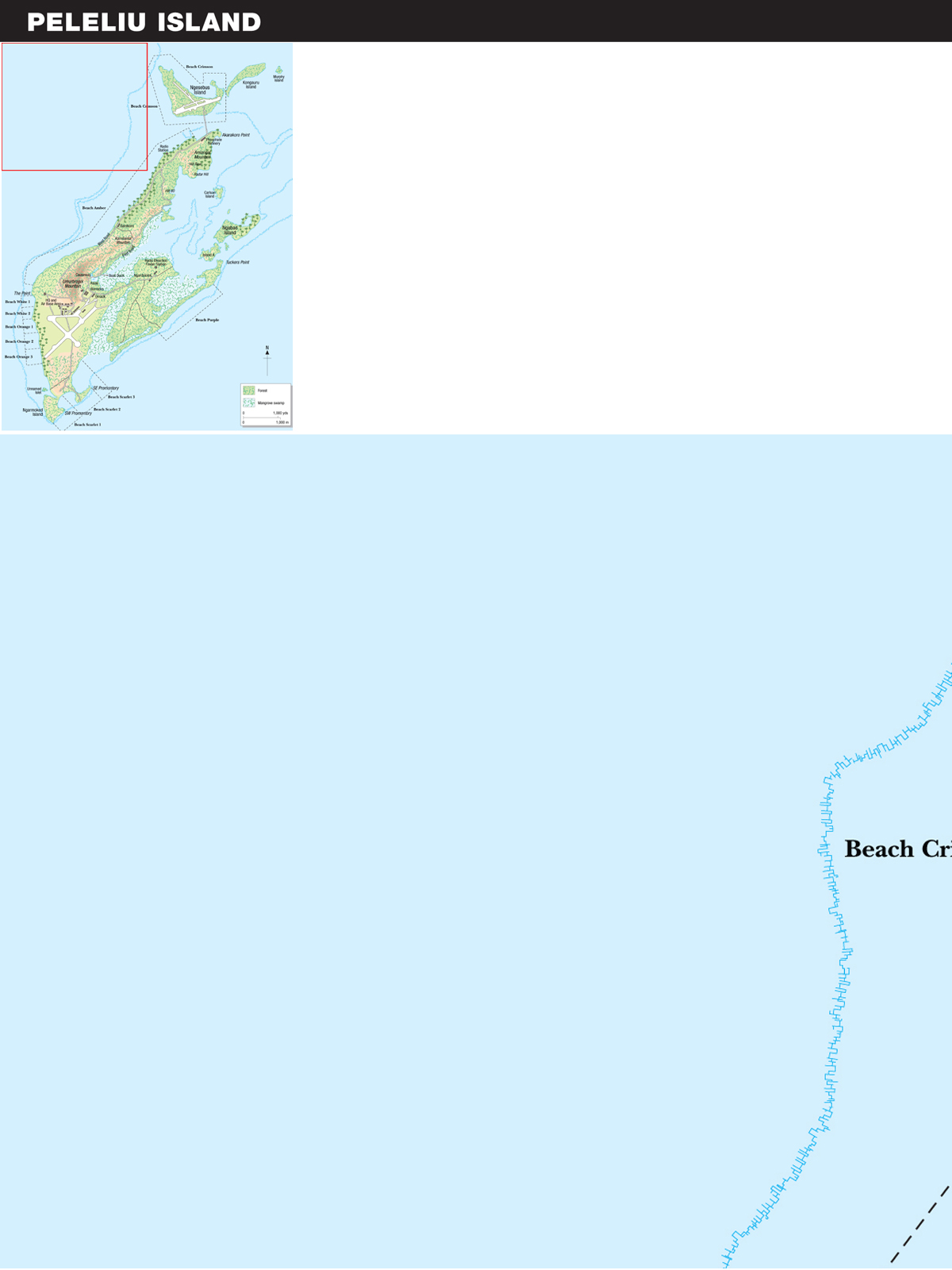




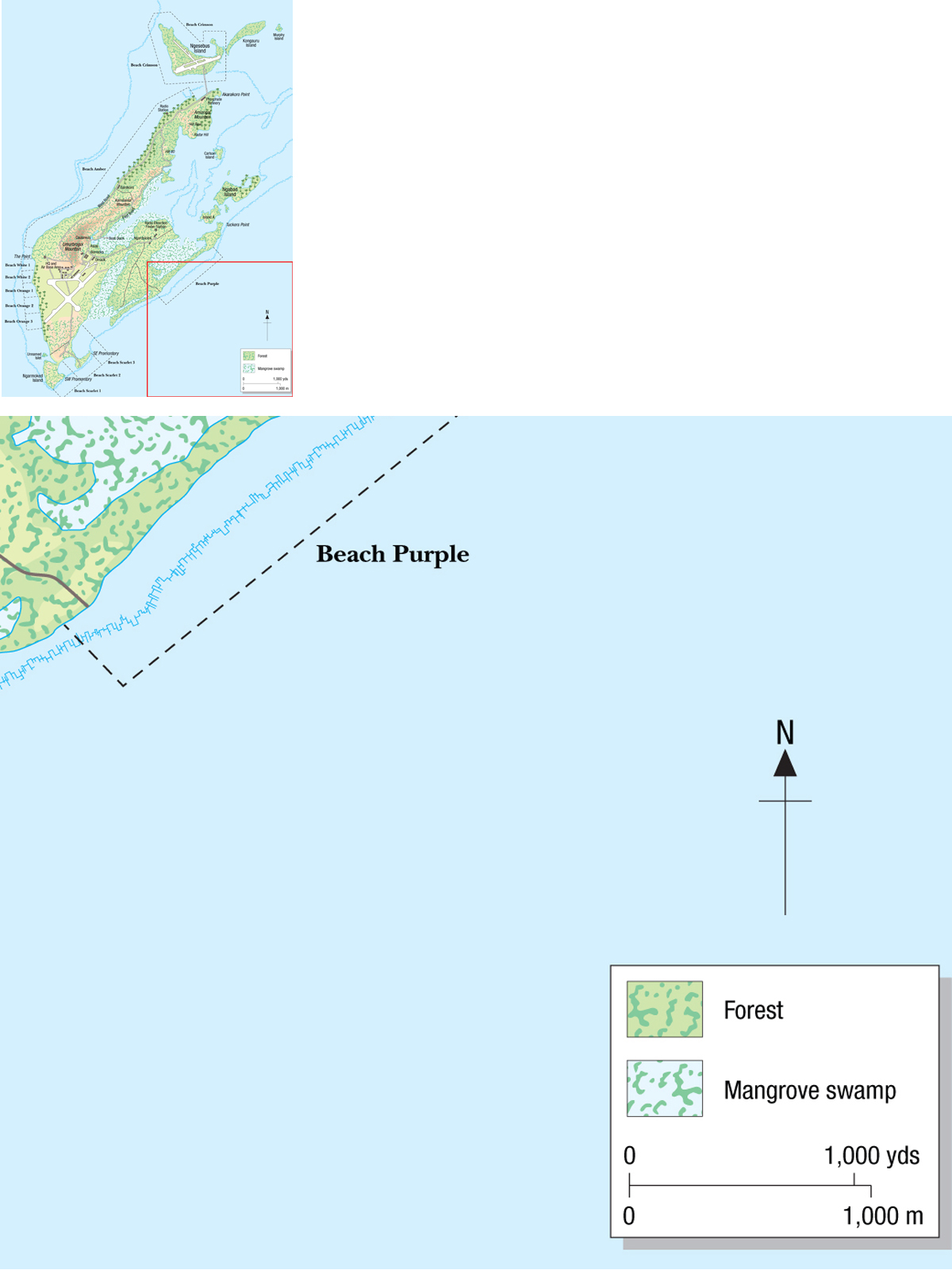
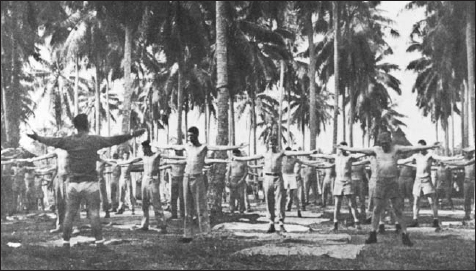
Calisthenics before breakfast. Men of the 1st Mar. Div. exercising on Pavuvu prior to debarkation for Peleliu, in an effort to bring their physical fitness up to scratch.
3. Beach Amber along the northwest coast was where the reef was widest and the northern flank was under enfilade fire from nearby Ngesebus Island. Some 300 yards inland high ground dominated the low-lying beach and failure to take this terrain would leave the beachhead under murderous artillery fire. Beach Amber was, therefore, also rejected.
4. That left Beaches White and Orange along the western coast. These provided the opportunity for a drive straight across the island from west to east over the airfield. This was the option finally chosen as the most viable.
The initial assault called for the three regimental combat teams, the 1st, 5th, and 7th Marines, to land abreast on 2,200-yard wide beachhead, each with one of their three battalions as regimental and divisional reserve. The 1st Marines (less 1/1 in regimental reserve) would land on the left flank on White Beach 1 and 2 and push inland to a pre-determined point, then wheel left to attack the southwest end of the Umurbrogol Mountains, which extended up the northeast peninsula. The 1st Marines would then push northeast along the coastal plain and the “high ground” – as intelligence described the Umurbrogol Mountains, all the way to the northern tip of Peleliu and on to Ngesebus Island, supported by the 5th Marines on their right flank.
In the center, the 5th Marines would land two battalions; one each on Orange Beach 1 and 2. The battalion on the left would link up with the 1st Marines, the other would drive straight across the airfield to the eastern shore. The 3/5, the regimental reserve, would land at H+1 (1 hour after the initial landing), pass between the other two battalions, and then participate in the movement northwards.
The 7th Marines, on the right flank, would land two battalions in column on Beach Orange 3, with their 3rd Battalion kept as divisional reserve. The two battalions ashore were to drive across to the eastern shore on the flank of the 5th Marines, then wheel right and mop up the isolated enemy forces in a drive to the southeastern tip of the island.
The 11th Marines, reinforced with IIIAC’s 3rd 155mm Howitzer and 8th 155mm Gun Battalions, would land at H+1 on Beaches Orange. The 75mm pack howitzers of 1/11 and 2/11 would provide direct fire support to 1st and 5th Marines, respectively. The 105mm howitzer-armed 3/11 would support the 7th Marines and the like-armed 4/11 would provide general support to the Division along with the two 155mm battalions. All battalions were to be in-place by H+5 and would be prepared to concentrate their fires on the southwest end of the Umurbrogol Mountains. The 8th Battalion’s 155mm “Long Tom” guns would also be positioned to provide fire support to the Army on Angaur 7 miles to the southwest. However, this support was never requested.
The 81st Inf. Div. was allocated to assault the island of Angaur, but only when the assault on Peleliu was considered “well in hand.” Until then the 81st would become the IIIAC Reserve. Angaur would be assaulted by two of the 81st Inf. Div.’s three RCTs, the third being detached to seize Ulithi. The date for the invasion of Angaur would be set by the 1st Mar. Div. commander, MajGen Rupertus.
Landings would be made on two of Angaur’s beaches simultaneously. The 322nd RCT would land on the northern Beach Red, then they would push inland, moving south and west across the island with its left flank tying in with the other assault combat team, the 321st RCT.
Landing on the eastern Beach Blue, the 321st RCT would move inland west and south across the island, with its right flank tying in with the 322nd RCT’s left. Upon securing Angaur, the 81st Inf. Div. would revert to IIIAC Reserve, initially, and then garrison Peleliu and Angaur after these islands were declared secure. The 1st Mar. Div. would return to its base on Pavuvu Island.
With the collapse of the Japanese outer frontier, the various island garrisons took on a much greater significance as part of the new “Absolute National Defense Zone.” Imperial Japanese Navy (IJN) air, service, and construction units, and guard forces were the main units providing the defense under the 30th Base Force commanded by Vice Admiral Ito Yoshioka along with Imperial Japanese Army (IJA) service and sea transport units of the 57th Line of Communications Sector Unit under MajGen Yamaguchi Takso. It was subsequently reorganized into the 53rd Independent Mixed Brigade (IMB).
With the fall of the Marshall Islands and the neutralization of Truk, combined with carrier-based air strikes on the Caroline Islands, the possibility of a US invasion of the Palau Islands seemed much more likely. Truk is in the Eastern Carolines and, with its major naval and airbase, was considered the “Pearl Harbor” of the Japanese Mandate. The 14th Division, which had been transferred from mainland China to New Guinea but re-directed to Saipan, was subsequently diverted to the Palaus, where it arrived in April 1944. The commander of the 14th Division, LtGen Inoue Sadao, established his headquarters on Koror Island and deployed units to garrison Babelthuap, Peleliu and Angaur, which he considered likely targets for invasion by the Americans. The 14th Division served as the Palau District Group while the 2nd Infantry (Reinforced) was designated the Peleliu Sector Unit. The 1st Battalion, 59th Infantry (Reinforced) served as the Angaur Sector Unit.
Operationally, the defense of the Palaus was the responsibility of the 31st Army headquartered on Truk under LtGen Obata Hideyoshi. When Saipan fell in August the command was transferred to the Southern Army in Manila, the Philippines under the command of Field Marshal Count Terauchi Hisaichi.
For the defense of Peleliu, Col Nakagawa had split the island into four defense districts. The North District was defended by the 346th Independent Infantry Battalion, 53rd IMB under the command of Maj Hikino; South District by the 3rd Battalion, 15th Infantry under Capt Chiaki; East District by the 3rd Battalion, 2nd Infantry under Capt Harada, and finally the West District defended by the 2nd Battalion, 2nd Infantry under Maj Timita. The 1st Battalion, 2nd Infantry under Capt Ichioka, the 14th Division Tank Unit and Engineer Company served as the Peleliu Sector Unit Reserve directly under Capt Sakamoto, second in command of the 2nd Infantry.
In addition there were to be support units of artillery, tanks, and engineers. The Japanese planned for both defense of the beaches as well as a defense in depth, following along the lines set out by Koror headquarters in its “Palau District Group Training for Victory” order of 11 July 1944. Here headquarters stated: “The ultimate goal of this training is to minimize our losses in the severe enemy pre-landing naval and aerial bombardment and, on the very night of the enemy landing, to take advantage of the fact that their equipment is not fully consolidated, to destroy their bridgehead at one blow.” It also stated that “we must recognize the limits of naval and aerial bombardment. Every soldier and civilian employee will remain unmoved by this, must strengthen his spirits even while advancing by utilizing lulls in enemy bombardment and taking advantage of the terrain according to necessity.” This Nakagawa would do to great effect, taking full advantage of the numerous coral caves and sinkholes, particularly in the area of the Umurbrogol Mountains. There were to be no mass suicidal banzai charges, but instead a long drawn-out battle of attrition, intended to bleed the Americans white. Peleliu would be the first occasion on which American troops encountered these tactics, but they would meet them again in the future on Iwo Jima and Okinawa.
The Americans anticipated the operations on Peleliu and Angaur would be over within one week, MajGen Rupertus declaring “It will be a short operation, a hard-fought ‘quickie’ that will last four days, five at the most, and may result in a considerable number of casualties. You can be sure, however that the 1st [Marine] Division will conquer Peleliu.” Rupertus was right about the “considerable casualties,” but the 1st Mar. Div. would not take Peleliu alone, and it would be months, not days, before Peleliu was conquered.
As for the Japanese, even though Peleliu would fall to the Americans eventually, the concept of well-prepared defenses, both on the beaches and in depth, would be proven well founded. Also, the use of coordinated counter-attacks on a small scale over a long and protracted period replaced the previous frenzied banzai charges, so wasteful of troops’ lives. These would be far more effective in “bleeding the Americans white” and it was hoped they might buy enough time for Japan to negotiate a peace. This, unfortunately for the Japanese, would not be the case.